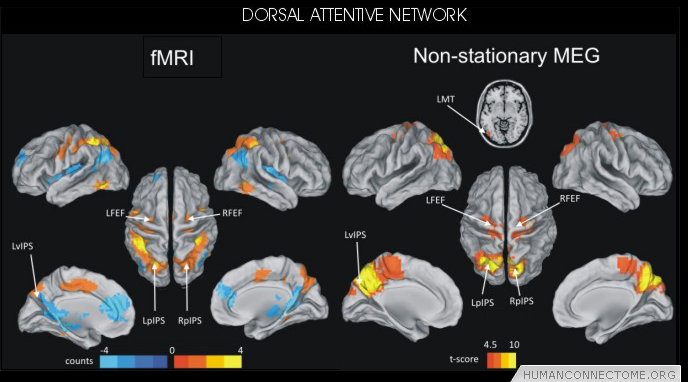- >>
- Healthy Adult Studies
- HCP Young Adult
- Project Protocols Detail
Components of the Human Connectome Project - Resting-State MEG
Resting state MEG (R-MEG) extends and complements resting-state fMRI by providing high temporal resolution data for analyzing the neuromagnetic correlates of fMRI connectivity, its time-frequency content, and high temporal resolution interactions.
R-MEG experiments are performed in much the same way as R-fMRI, with individuals resting in the MEG scanner either with their eyes open, closed or open and fixated on a target. No explicit cognitive or sensory tasks are performed. We simply measure the electrical activity of the brain “at rest.”

Figure 1: Source-space band-limited power (BLP) correlation maps obtained for the Dorsal Attentive Network. Left: fMRI seed based conjunction maps. Right: MEG t-statistic images across subjects computed using epochs of maximum correlation. The topography of the non-stationary MEG Resting State Network (RSN) is similar to the RSN obtained by fMRI.
R-fMRI and R-MEG/EEG both represent physiological measures in which functional connectivity may be measured by the degree to which structures (nodes) share signals. Our preliminary results (e.g. Figure 1) show good correspondence between R-fMRI and R-MEG connectivity patterns, and indicate that functional connectivity is non-stationary at high temporal resolution. Analyses of resting state electrophysiology datasets are focused on (i) coherence analysis of electrophysiological activity; (ii) correlation analysis of time series representing band-limited power (BLP) fluctuations; (iii) multivariate autoregressive (MVAR) analyses providing measures of directional interactions.
Assigning the electrophysiological data from R-MEG with parcellated connectome data will enable: (i) studies of how the regulation of synchronous neuronal activity enables the brain to mediate behavior; (ii) analyses of heritability of electrophysiological responses; and (iii) estimates of directed interactions among different cortical parcels.